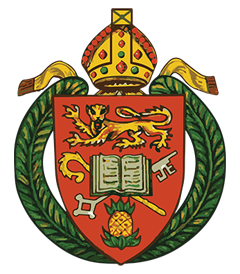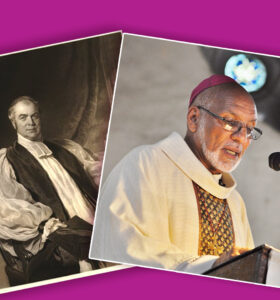FROM LIPSCOMB TO GREGORY
ANGLICANS IN JAMAICA 1655-2024 – A BIRD’S-EYE VIEW
BY PROFESSOR EMERITUS, PATRICK E. BRYAN
The Year 1824 was a watershed for the Anglican Church in Jamaica. It marked the establishment of the Diocese of Jamaica on July 24 and the consecration of the first Bishop, Dr. Christopher Lipscomb, one day later. In February 1825, Bishop Lipscomb arrived in Jamaica. He was warmly welcomed with much military pageantry and salutes in Port Royal, Port Henderson and Spanish Town, and was later installed at the St. Catherine Parish Church (now Spanish Town Cathedral).
With a newly minted mandate, The Bishop was first, to serve in the Diocese of Jamaica – which then included the Bay Islands of Honduras (Belize), the Bahamas, and the Turks and Caicos Islands. Second, the new Diocese was to provide religious instruction to the enslaved population – which the Anglican Church had failed to do for over 200 years. The attempted reform started in the 1790s with wholesale baptism but was indifferent about providing religious instruction.
By December 1825, The Jamaican House of Assembly passed “The Clergy Act,” investing the Bishop with ecclesiastical jurisdiction over the Jamaican clergy. A resident Bishop removed the need for oversight by the distant Bishop of London, and gradually transferred to Bishop Lipscomb the authority of the Governor of Jamaica to appoint clergy.
However, the Jamaican House of Assembly continued to pay all Anglican clergy, except for the Bishop, the Archdeacon and six priests, who were funded from Britain. Lipscomb approached his ministry with missionary zeal and laid the foundation for the establishment of the Diocese of Jamaica and the Cayman Islands, as we know it today, with many notable achievements…
The Lipscomb Era
- The new Bishop raised salaries, divided the Diocese into three Deaneries, corresponding to the counties of Cornwall, Middlesex and Surrey, run by three senior clergymen, and he embarked on a programme of religious instruction to the enslaved population. Lipscomb consecrated 31 churches in Jamaica, some financed by planters, others by public contribution and assistance from the Government (public purse).
- The mission of religious instruction to the enslaved was advanced through Sunday Schools and Church Schools (attached to the various churches). Emphasis was on Religious education but in many cases, Arithmetic and Psalmody or the singing of Psalms were introduced. Urban centres provided literacy education, while the emphasis in rural areas was on oral instruction, since many planters refused to allow literacy education on their estates.
- Bishop Lipscomb established over 50 national schools, which emphasized religious education, and trained catechists who were responsible for teaching the principles of the Christian religion.
These included catechists who were enslaved. Central Branch in Kingston became the centre for the training of teachers and catechists, usually coloured Jamaicans. Bishop Lipscomb died in 1843.
Disestablishment and Beyond
Bishop Lipscomb’s immediate successor, was Bishop Aubrey Spencer, who renovated the St. Catherine Parish Church, which became the Anglican Cathedral. In 1870, Spencer’s successor, Bishop Reginald Courtenay, faced the challenges of disestablishment and disendowment, as all subventions to the Anglican Church in Jamaica were terminated by the British Parliament. With this change the established church in Jamaica, was restructured by the Synod in 1870. New administrative and financial structures/systems were implemented to enable the Church to become self-financing, incorporating the laity. The architect of the new financial administration was Rev. Enos Nuttall, who became Bishop of Jamaica in 1880.
Following disestablishment, black congregations became the main financial support of the church, with some support from property owners (local and overseas).
The Nuttall Era
- Bishop Nuttall established a theological college (later St. Peter’s College), that trained more local clergy for Jamaican and overseas missions. The employment of coloured Jamaican catechistsunder the Lipscomb administration was now followed by a more general indigenization of clergy – to include black clergy. This process was accelerated in the twentieth century, as The Church placed great emphasis on the employment of catechists, and native clergy.
- There was also an extension of the Church’s role in establishing elementary, preparatory and secondary schools across the island.
- Apart from schools such as St. Hilda’s Diocesan High School and St. Hugh’s High School for Girls, which were established during Bishop Nuttall’s administration (1884-1916), this pioneer in education was Chairman of the Jamaica Schools Commission, and for more than 30 years, he also chaired the Board of the Mico Training College (now the Mico University College) and the Shortwood Teachers’ College for women.
- The Kingston Charity Organisation founded by Enos Nuttall was particularly concerned with the reduction of urban poverty. During his tenure, there were also important inputs in health, advanced especially by Deaconesses introduced into Jamaica in the 1890s. The training of nurses and midwives was followed by the establishment of a Nurses’ Union, and the Nuttall Nursing Home. Nuttall Hospital which observed 100 years in 2023, was built in 1923 in memory of Enos Nuttall.
- This spiritual leader and nation-builder is remembered particularly for his role in spearheading the rebuilding programme in Kingston following the devastation of the 1907 earthquake.
The 20th Century
The establishment of educational institutions such as DeCarteret College in Mandeville (1916) and Kingston College (1925) continued throughout the 20th Century.
- Under Bishop Percival Gibson, the first black Jamaican Bishop, there was a spike in the growth of secondary schools: The Queen’s School 1954, Glenmuir High and Bishop Gibson High and in 1965, the Gibson administration established Church Teachers’ College.
- Establishment of churches continued in both rural Jamaica and in Kingston which continued to expand as a commercial centre in the late nineteenth and early twentieth centuries and was the major target of rural-urban migration.
- The Anglican Church also focused on social development, establishing homes for Senior Citizens/Golden Agers, orphans and wards of the State. These include the Wortley Home for Girls, in Constant Spring; St. Monica’s Home in Chapelton, Clarendon and the Clifton Boys’ Home in Westmoreland.
- As part of the human development thrust, The Rev. Henry Clarke, a Rector in Westmoreland, established the Westmoreland Building Society which grew to become The Jamaica National Group; and Archdeacon Downer founded the Victoria Building Society in Kingston, both intended to provide housing.
- The structure of the Diocese has been modified since the late twentieth century. One of the most significant changes in this respect has been the admission of women to ordained ministry since 1996.
- Both Mandeville and Montego Bay have joined Kingston as Regional Centres, with Kingston and Montego Bay being led by Suffragan Bishops.
- Beginning with Bishop Gibson’s incumbency, all Bishops except for three, have been Jamaican: Namely, Herbert Edmondson, William Murray and Harold Daniel, (Mandeville), Cyril Swaby, Neville deSouza, Alfred Reid, Howard Gregory, Leon Golding (Montego Bay); Herman Spence, Robert Thompson and Garth Minott (Kingston).
Bishops Gibson, Edmondson, Swaby, deSouza, Reid and Gregory all become Diocesan Bishops.
The Gregory Era
Archbishop Gregory who was consecrated as the 14th Diocesan Bishop in 2012, was elected as the 13th Archbishop of the Province of the West Indies in 2019.
As Archbishop, he has oversight for the eight Dioceses in the English-speaking
Caribbean.
A respected voice in the local ecumenical fraternity and the worldwide Anglican
Communion, he is now steering the Church to create a more indigenous and
responsive institution to the meet needs of our changing society.
Professor Emeritus Patrick E. Bryan
February 1, 2024

